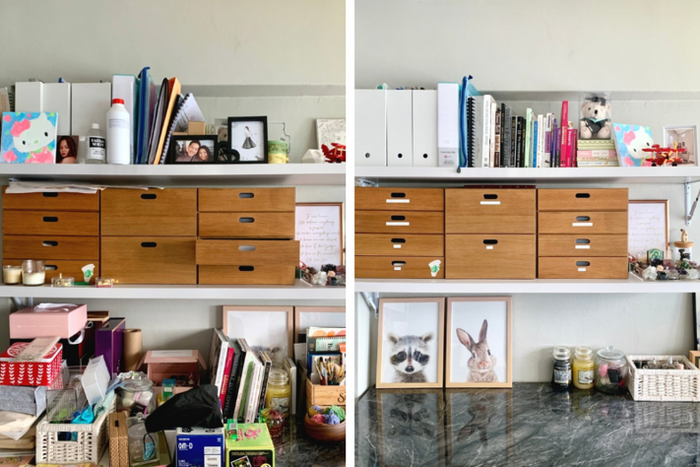No more “I wish I knew” woes.
There’s no doubt that a well-kept home doesn’t just look good — it makes you feel good too. But you can probably relate to the struggles of clutter building up and feeling lost on how to maintain a neat and tidy home.
Just imagine poorly-designed corners that make them under-utilised or inaccessible, or finding things where they don’t belong.
Not all hope is lost though! With the right storage planning, you can set up a better storage and organisation system that actually lasts.

Source: Orderly
We spoke with certified Organisational Specialists Rae and Vanessa, founders of Orderly – which offers services ranging from decluttering to zone and product planning.
Here are the key storage planning tips they’ve shared with us to save you headaches in the future!
1. Hidden or visual?: find out your family’s organising style

View this project by Style Elements Studio
Chances are, you’ve wondered at least once about why things get messed up even though you organised them not too long ago. As Rae shares, you might even end up frustrated with your spouse who just can’t seem to keep things where they belong, or your children leaving their toys strewn everywhere despite having a dedicated storage set-up.
According to Vanessa, the most likely reason is that “it’s not the right system for your household”. She adds that “if the designs align with an organising style that you are naturally more inclined to, and works for the household, it’s easier to keep the house tidy in the long-term.”

View this project by Ataz Haus Interior Design
That’s why one of the first things you should do before even planning for storage is to figure out your organising style – that is, whether you’re a visual or hidden organiser. Rae and Vanessa recommend doing any simple quiz available online (like this one) to figure it out.
Visual organisers might prefer open shelving and storage solutions like hooks and pegboards. On the other hand, hidden organisers go for cupboards and drawers to keep things hidden away.
Importantly, this varies from person to person; if you’re moving in with your spouse and children, get them to figure out their organising style too.
Not only will this guide your renovation choices, but it will also make maintaining your home much easier.

Source: Orderly
If you’re not sure how to get started, you can reach out to the team at Orderly.
With their Storage Planning And Cabinetry Evaluation (SPACE) service, they’ll first help you to understand more about your organising style and get a better idea of your lifestyle needs.
They even go into the nitty-gritty details like your hobbies and interests, and whether you’re intending to have kids, since these will shape your storage needs.
2. Figure out the categories of items you need to store

View this project by Aart Boxx Interior
As Rae says, a good time to evaluate your storage needs is “before you meet your ID for the first time” as it will “greatly facilitate the discussion with [them]”.
One key step in figuring out how to plan your storage is first knowing what you have in your inventory. That means decluttering and sorting out your belongings into categories.
“For instance, young BTO homeowners moving out of their parent’s homes might have childhood stuff like school notes and soft toys to clean out,” shares Rae.

View this project by Loft.9 Design Studio 九阁设计
After you’ve decluttered and sorted your items into categories, list them down and where you intend to store them in your new home. For example: clothes, shoes, books and kids’ toys.
“We also have clients with collections that require custom storage – musical instruments, luxury bags and accessories, to name a few,” Rae adds. “Or perhaps you bake or cook often, which means you’ll have a lot of cookware to store.”
Pro-tip: Keep a bin in the wardrobe for clothes your young children outgrow. Pack and label them with the size (e.g. “3 to 6 months”) to reuse if you’re having another child. Once the bin is full, clear it out and consider donating/selling the pieces to reclaim wardrobe space. Adults can do this too, especially for clothes that don’t fit your style anymore.
3. Consider how to design for your storage needs

View this project by Comfort Home Interior
With a better idea of what you need storage for, it’s time to think about how to store them. Consider as well the size of your home; if you’re working with limited space, “the key principle would be to go vertical,” says Rae.
Whether it’s hanging items up with behind-door storage like hooks, stackable drawers or built-in upper cabinets, vertical solutions help you to maximise space.
To make sure you cover all bases, here are a few key questions to think about as you consider the different rooms.
You can also discuss these with your ID at your first meeting for a more fruitful meeting.
Should you opt for built-in storage or loose furnishing?

View this project by Third Avenue Studio
There are a variety of considerations like cost, quality and functionality when deciding between built-ins and loose furnishings.
Besides that, think about your lifestyle needs, interests and hobbies. Rae and Vanessa also highlighted storage spaces that are often overlooked:
- A ‘drop zone’ at the entrance – for storing bags, keys, bicycles and other items on your way out/back into your home.
- A storage closet or corner for cleaning products like tall mops and brooms – this could be a dedicated built-in or an unused corner with hooks/grips
- A niche or sturdy caddy/shelf in the bathroom for shower items

View this project by Posh Home
If you intend to do built-ins, would cabinets or drawers be better?

View this project by The Local INN.terior 新家室
Rae and Vanessa point out that while drawers are more expensive, they’re the better option for easily accessing items placed at the back.
“A general tip for (bedroom) wardrobes is to avoid deep drawers, unlike in kitchens. They’re difficult to organise clothes in and you might have to stack up your clothes inside, which is inconvenient,” adds Rae.
How tall should the drawer and shelf heights be?

View this project by Fifth Avenue Interior
Since this is difficult to figure out on your own, don’t forget to ask your ID what drawer and shelf heights they recommend for your needs! This includes spaces like your wardrobe which are best customised to suit the items you want to store.
Pro-tip: To keep your wardrobe flexible, you can choose to have two hanging rods – one at the top and one removable one in the middle. In case you need temporary drawers, like for baby clothes, this allows you to remove the bottom rod and use packable drawers for as long as you need to.

View this project by Luova Project Services
Vanessa recommends having two separate sections for short- and long-hanging clothes. Assuming you have two hanging rods in the short-hanging section, you can have tops at the top and bottoms – you guessed it – at the bottom.
That way, you can organise long-hanging clothes in the second section without them touching anything in the middle of the wardrobe and getting rumpled.
Accessories like belts and scarves can go into drawers, or hung up depending on how many you have.
If you own a fair bit of winter clothing, you can keep them on the uppermost shelves or vacuum seal and store them elsewhere like in the storeroom.
Is the storage unit’s design ergonomic and easy to access?

View this project by ChengYi Interior Design
Here’s one last thing: check whether the design you have in mind is ergonomic and easily accessible.
“One of our clients had a landed property with a really high ceiling. The problem was that the upper kitchen cabinets went up nearly as high as the ceiling, so even a regular ladder wasn’t enough to reach the topmost shelf,” shares Rae. “It’s an extreme example, but highlights that planning with accessibility in mind ensures that the storage you install doesn’t end up a waste.”

Pull-out cabinet trays for dead corners | View this project by IDesignerLab
‘Dead’ or underutilised corners are also something Rae and Vanessa have encountered often. For example, while corner built-ins provide storage, they can be difficult to access and you might not be able to see what’s inside at one glance, like with kitchen cabinets.
In such cases, a simple solution you can consider is using lazy Susans or pull-out trays; bring it up to your ID to see if they can assist you with finding a suitable one or customising one for your space.
One more point to keep in mind is the placement of your doors, to ensure optimal accessibility. You wouldn’t want to deal with obstructed swing space, or doors that block other carpentry when open!
4. Future-proofing: looking at the bigger picture

View this project by PHD Posh Home Design
Another consideration is future-proofing: you might be planning to have kids in the future, or you’re undecided about whether your new place will be your forever home.
In such cases, Rae and Vanessa advise against doing too many built-ins; it would be better to keep spare rooms/studies flexible to convert to a nursery or to change things up as children grow older.
Plus, potential buyers tend to prefer homes with fewer built-ins.
5. Review internal carpentry structure in the proposed 3D drawing

View this project by Page Studio
After your initial discussion with your ID and they share the proposed 3D drawing, have a close look at the storage spaces – especially what the interior of wardrobes and cabinets look like.
Make sure all the considerations you have in mind are accounted for, and run through it one more time to be sure you haven’t missed anything before you share your feedback with your ID.

Source: Orderly
If you’re confused about how to evaluate whether the proposed design meets your storage needs, the SPACE service by Orderly has you covered: they’ll review your ID’s render and provide practical recommendations based on your organising style, spaces and lifestyle that you can share with your ID.
As part of the service, at the end, the team will share a summary of their recommendations along with a catalogue of organising products recommended for your organising style that you can purchase in your own time.
Proper storage planning goes a long way for a comfy and well-organised home
For help with evaluating the 3D drawing your ID has shared with you, get in touch with the experts at Orderly for suggestions tailored to your needs.
Limited promotion:
Get a 15% discount on Orderly’s SPACE service when you quote “Qanvast”. Don’t wait too long though – this offer is only valid for the first 50 clients!
This article was written in collaboration with Orderly.

 Get a budget estimate before meeting IDs
Get a budget estimate before meeting IDs